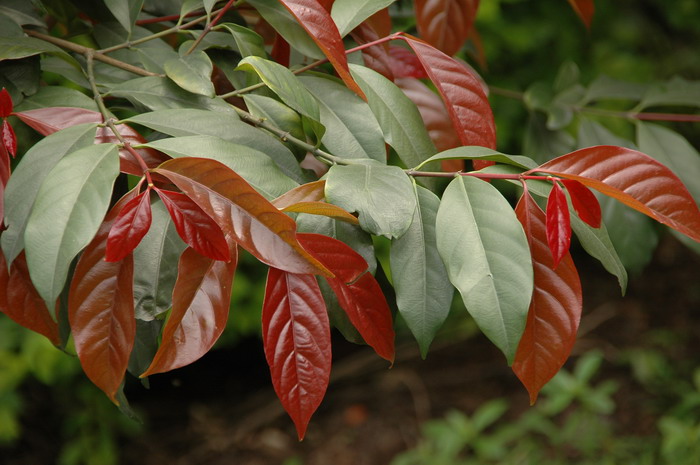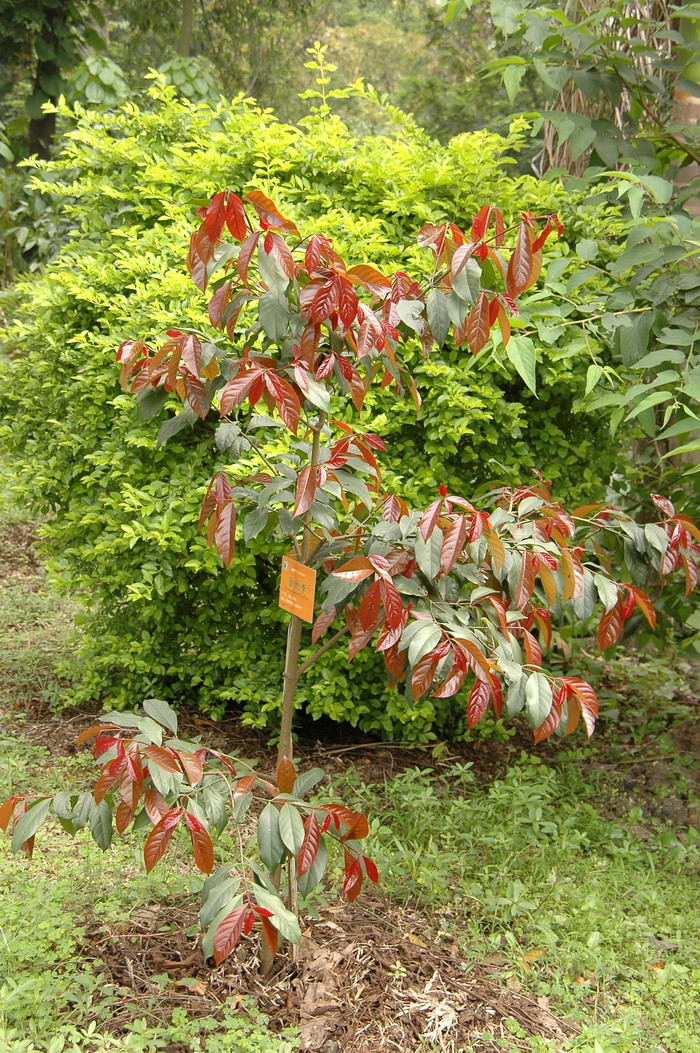金丝李 Garcinia paucinervis
中文名(Chinese Name):金丝李
学名(Scientific Name):Garcinia paucinervis Chun et How
英文名(English Common Name):
别名(Chinese Common Name):埋贵
异名(Synonym):
科属(Family & Genus):藤黄科(Guttiferae)藤黄属
形态特征(Description):乔木,高3-15(-25)厘米;树皮灰黑色,具白斑块。幼枝压扁状四稜形,暗紫色,干后具纵槽纹。叶片嫩时紫红色,膜质,老时近革质,椭圆形,椭圆状长圆形或卵状椭圆形,长8-14厘米,宽2.5-6.5厘米,顶端急尖或短渐尖,钝头、基部宽楔形,稀浑圆,干时上面暗绿色,下面淡绿或苍白,中脉在下面凸起,侧脉5-8对,两面隆起,至边缘处弯拱网结,第三级小脉蜿蜒平行,网脉连结,两面稍隆起;叶柄长8-15毫米,幼叶叶柄基部两侧具托叶各1枚,托叶长约1毫米。花杂性,同株。雄花的聚伞花序腋生和顶生,有花4-10朵,总梗极短;花梗粗壮,微四稜形,长3-5毫米,基部具小苞片2;花萼裂片4枚,几等大,近圆形,长约3毫米;花瓣卵形,长约5毫米,顶端钝,边缘膜质,近透明;雄蕊多数(约300-400),合生成4裂的环,花丝极短,花药长椭圆形,2室,纵裂,退化雌蕊微四稜形,柱头盾状而凸起。雌花通常单生叶腋,比雄花稍大,退化雄蕊的花丝合生成4束,束柄扁,片状,短于子房,每束具退化花药6-8,柱头盾形,全缘,中间隆起,光滑,子房圆球形,高约2.5毫米,无稜,基生胚珠1。果成熟时椭圆形或卵珠状椭圆形,长3.2-3.5厘米,直径2.2-2.5厘米,基部萼片宿存,顶端宿存柱头半球形,果柄长5-8毫米;种子1。花期6-7月,果期11-12月。
分布(Distribution):产广西及云南,多生于海拔300-800米石灰岩山较干燥的疏林或密林中。
用途(Use):本种为我国季风型气候、石灰岩地形地区的特有珍贵用材树种,心边材明显,材质坚而重,结构细致均匀,适于水工建筑和梁柱等用材。
引自中国植物志英文版FOC Vol. 13 Page 1, 41, 44
Garcinia paucinervis Chun & F. C. How, Acta Phytotax. Sin. 5: 12. 1956.
金丝李 jin si li| Clusiaceae | Garcinia
Trees 3-15(-25) m tall. Bark gray-black, white spotted. Young branchlets dark purple, depressed tetragonous, longitudinally sulcate when dry. Stipules 2, ca. 1 mm; petiole 0.8-1.5 cm; leaf blade purple-red when young, abaxially greenish or glaucous when dry, adaxially dark green, elliptic, elliptic-oblong, or ovate-oblong, 8-14 × 2.5-6.5 cm, membranous when young, becoming subleathery, midvein raised abaxially; secondary veins 5-8 pairs, raised on both surfaces, curved and connected at leaf margin; tertiary veins sinuous, parallel, joined by veinlets, slightly raised on both surfaces, base broadly cuneate, rarely rounded, margin cartilaginous, involute, apex acute or shortly acuminate, with obtuse or rounded acumen. Plant monoecious. Male flowers 4-10, in terminal and axillary short pedunculate cymes; pedicels robust, slightly tetragonous, 3-5 mm, 2-bracteolate at base; sepals 4, nearly equal, suborbicular, ca. 3 mm; petals ovate, ca. 5 mm, margin membranous and subtransparent, apex obtuse; stamen fascicles connate forming a 4-lobed ring of 300-400 stamens; free part of filaments very short; anthers narrowly elliptic, 2-celled, cells longitudinally dehiscent; pistillode subtetragonous; stigma peltate, convex. Female flowers usually solitary and axillary, slightly larger than male ones; staminodes of fascicles 4; fascicle stalks complanate, lamellate, shorter than ovary, each fascicle with 6-8 rudimentary anthers; ovary globose, ca. 2.5 mm, not angular, 1-loculed; stigma peltate, convex, smooth, entire. Mature fruit ellipsoid or ovoid-ellipsoid, 3.2-3.5 × 2.2-2.5 cm, smooth; sepals persistent. Seeds 2. Fl. Jun-Jul, fr. Nov-Dec.


● Rather dry sparse or dense forests on limestone mountains; 300-800 m. SW and W Guangxi, SE Yunnan (Malipo).
This is a valuable timber species but is vulnerable to extirpation because of its restricted and scattered distribution, overcutting, and poor seed germination and natural reproduction. The wood is hard, heavy, and extremely water-tolerant. It is used for shipbuilding, construction, quality furniture, and in the military industry.
The species is similar to Garcinia stipulata T. Anderson but differs in having fewer secondary leaf veins, smaller male flowers, shorter pedicels, and a usually 1-seeded fruit.
(责任编辑:徐晔春)
学名(Scientific Name):Garcinia paucinervis Chun et How
英文名(English Common Name):
别名(Chinese Common Name):埋贵
异名(Synonym):
科属(Family & Genus):藤黄科(Guttiferae)藤黄属
形态特征(Description):乔木,高3-15(-25)厘米;树皮灰黑色,具白斑块。幼枝压扁状四稜形,暗紫色,干后具纵槽纹。叶片嫩时紫红色,膜质,老时近革质,椭圆形,椭圆状长圆形或卵状椭圆形,长8-14厘米,宽2.5-6.5厘米,顶端急尖或短渐尖,钝头、基部宽楔形,稀浑圆,干时上面暗绿色,下面淡绿或苍白,中脉在下面凸起,侧脉5-8对,两面隆起,至边缘处弯拱网结,第三级小脉蜿蜒平行,网脉连结,两面稍隆起;叶柄长8-15毫米,幼叶叶柄基部两侧具托叶各1枚,托叶长约1毫米。花杂性,同株。雄花的聚伞花序腋生和顶生,有花4-10朵,总梗极短;花梗粗壮,微四稜形,长3-5毫米,基部具小苞片2;花萼裂片4枚,几等大,近圆形,长约3毫米;花瓣卵形,长约5毫米,顶端钝,边缘膜质,近透明;雄蕊多数(约300-400),合生成4裂的环,花丝极短,花药长椭圆形,2室,纵裂,退化雌蕊微四稜形,柱头盾状而凸起。雌花通常单生叶腋,比雄花稍大,退化雄蕊的花丝合生成4束,束柄扁,片状,短于子房,每束具退化花药6-8,柱头盾形,全缘,中间隆起,光滑,子房圆球形,高约2.5毫米,无稜,基生胚珠1。果成熟时椭圆形或卵珠状椭圆形,长3.2-3.5厘米,直径2.2-2.5厘米,基部萼片宿存,顶端宿存柱头半球形,果柄长5-8毫米;种子1。花期6-7月,果期11-12月。
分布(Distribution):产广西及云南,多生于海拔300-800米石灰岩山较干燥的疏林或密林中。
用途(Use):本种为我国季风型气候、石灰岩地形地区的特有珍贵用材树种,心边材明显,材质坚而重,结构细致均匀,适于水工建筑和梁柱等用材。
引自中国植物志英文版FOC Vol. 13 Page 1, 41, 44
Garcinia paucinervis Chun & F. C. How, Acta Phytotax. Sin. 5: 12. 1956.
金丝李 jin si li| Clusiaceae | Garcinia
Trees 3-15(-25) m tall. Bark gray-black, white spotted. Young branchlets dark purple, depressed tetragonous, longitudinally sulcate when dry. Stipules 2, ca. 1 mm; petiole 0.8-1.5 cm; leaf blade purple-red when young, abaxially greenish or glaucous when dry, adaxially dark green, elliptic, elliptic-oblong, or ovate-oblong, 8-14 × 2.5-6.5 cm, membranous when young, becoming subleathery, midvein raised abaxially; secondary veins 5-8 pairs, raised on both surfaces, curved and connected at leaf margin; tertiary veins sinuous, parallel, joined by veinlets, slightly raised on both surfaces, base broadly cuneate, rarely rounded, margin cartilaginous, involute, apex acute or shortly acuminate, with obtuse or rounded acumen. Plant monoecious. Male flowers 4-10, in terminal and axillary short pedunculate cymes; pedicels robust, slightly tetragonous, 3-5 mm, 2-bracteolate at base; sepals 4, nearly equal, suborbicular, ca. 3 mm; petals ovate, ca. 5 mm, margin membranous and subtransparent, apex obtuse; stamen fascicles connate forming a 4-lobed ring of 300-400 stamens; free part of filaments very short; anthers narrowly elliptic, 2-celled, cells longitudinally dehiscent; pistillode subtetragonous; stigma peltate, convex. Female flowers usually solitary and axillary, slightly larger than male ones; staminodes of fascicles 4; fascicle stalks complanate, lamellate, shorter than ovary, each fascicle with 6-8 rudimentary anthers; ovary globose, ca. 2.5 mm, not angular, 1-loculed; stigma peltate, convex, smooth, entire. Mature fruit ellipsoid or ovoid-ellipsoid, 3.2-3.5 × 2.2-2.5 cm, smooth; sepals persistent. Seeds 2. Fl. Jun-Jul, fr. Nov-Dec.
● Rather dry sparse or dense forests on limestone mountains; 300-800 m. SW and W Guangxi, SE Yunnan (Malipo).
This is a valuable timber species but is vulnerable to extirpation because of its restricted and scattered distribution, overcutting, and poor seed germination and natural reproduction. The wood is hard, heavy, and extremely water-tolerant. It is used for shipbuilding, construction, quality furniture, and in the military industry.
The species is similar to Garcinia stipulata T. Anderson but differs in having fewer secondary leaf veins, smaller male flowers, shorter pedicels, and a usually 1-seeded fruit.
(责任编辑:徐晔春)
踩一下[0]

顶一下[3]